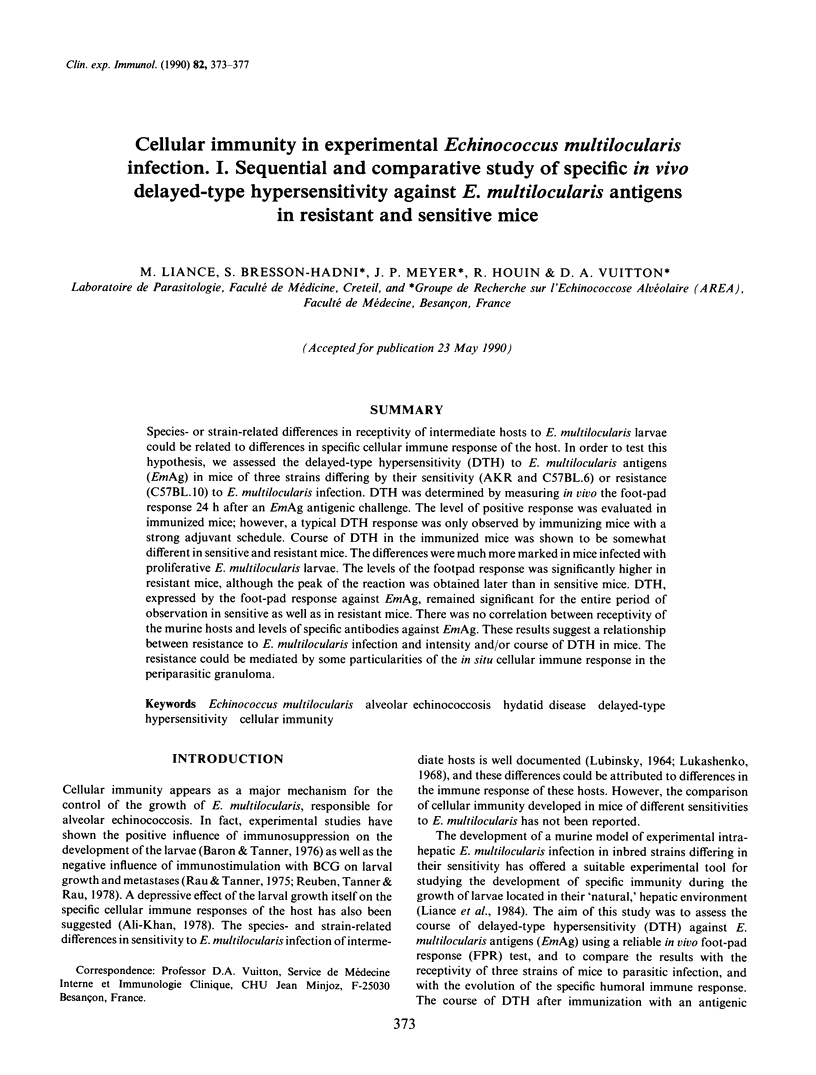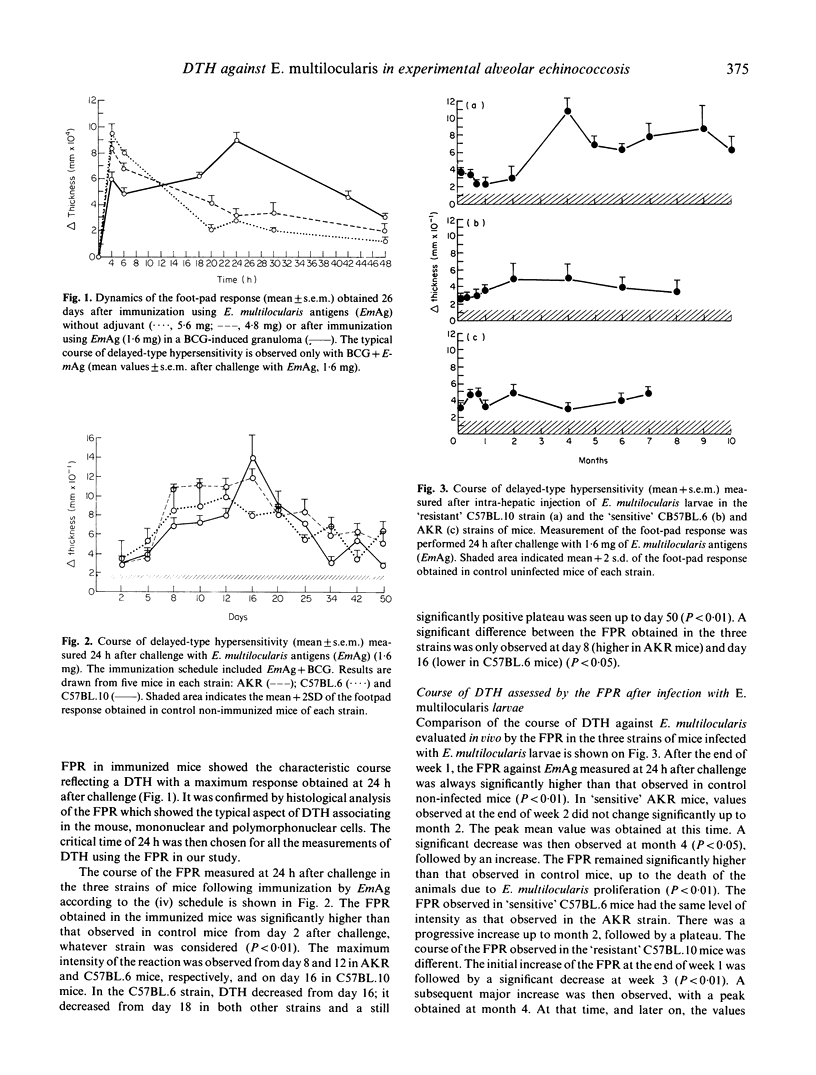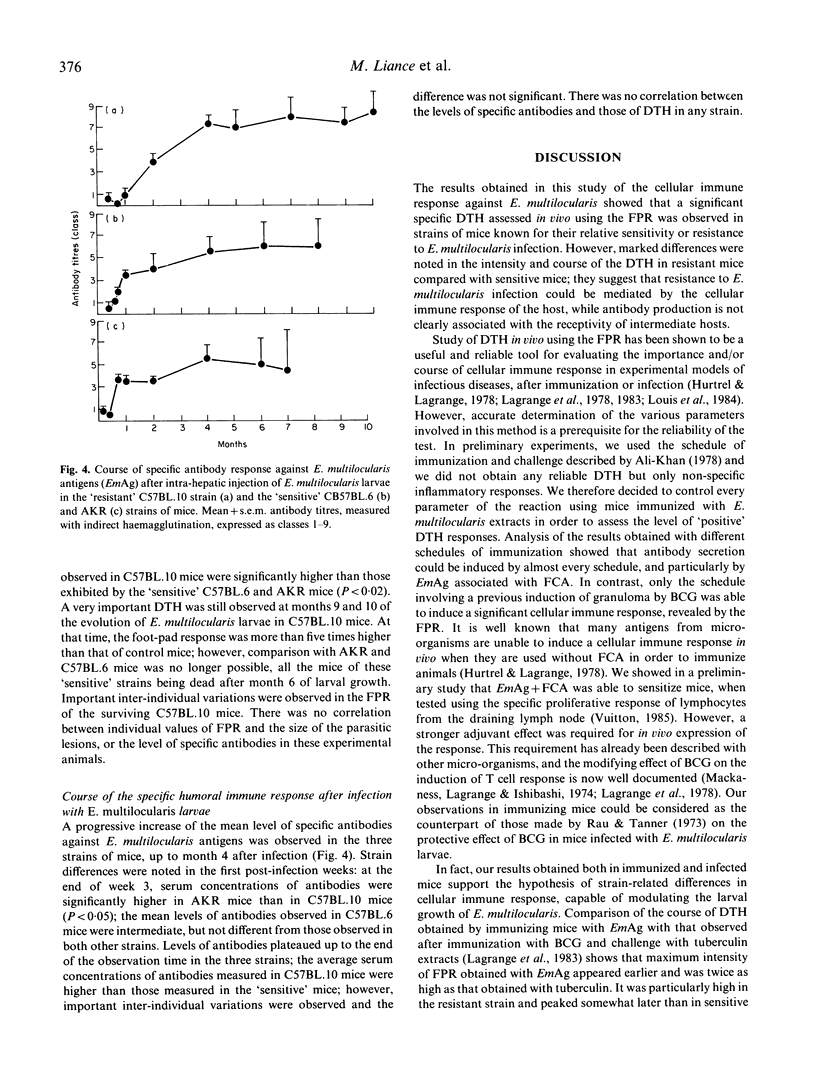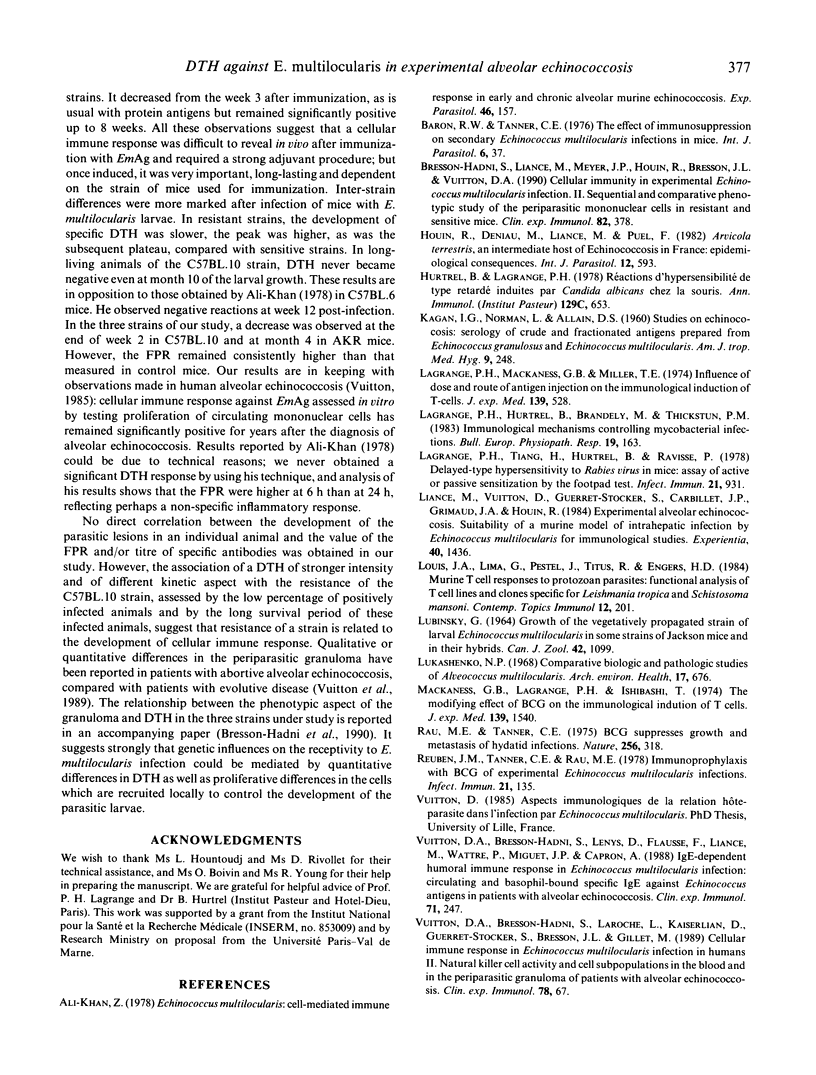Abstract
Species- or strain-related differences in receptivity of intermediate hosts to E. multilocularis larvae could be related to differences in specific cellular immune response of the host. In order to test this hypothesis, we assessed the delayed-type hypersensitivity (DTH) to E. multilocularis antigens (EmAg) in mice of three strains differing by their sensitivity (AKR and C57BL.6) or resistance (C57BL.10) to E. multilocularis infection. DTH was determined by measuring in vivo the foot-pad response 24 h after an EmAg antigenic challenge. The level of positive response was evaluated in immunized mice; however, a typical DTH response was only observed by immunizing mice with a strong adjuvant schedule. Course of DTH in the immunized mice was shown to be somewhat different in sensitive and resistant mice. The differences were much more marked in mice infected with proliferative E. multilocularis larvae. The levels of the footpad response was significantly higher in resistant mice, although the peak of the reaction was obtained later than in sensitive mice. DTH, expressed by the foot-pad response against EmAg, remained significant for the entire period of observation in sensitive as well as in resistant mice. There was no correlation between receptivity of the murine hosts and levels of specific antibodies against EmAg. These results suggest a relationship between resistance to E. multilocularis infection and intensity and/or course of DTH in mice. The resistance could be mediated by some particularities of the in situ cellular immune response in the periparasitic granuloma.
Full text
PDF




Selected References
These references are in PubMed. This may not be the complete list of references from this article.
- Ali-Khan Z. Echinococcus multilocularis: cell-mediated immune response in early and chronic alveolar murine hydatidosis. Exp Parasitol. 1978 Dec;46(2):157–165. doi: 10.1016/0014-4894(78)90128-5. [DOI] [PubMed] [Google Scholar]
- Baron R. W., Tanner C. E. The effect of immunosuppression on secondary Echinococcus multilocularis infections in mice. Int J Parasitol. 1976 Feb;6(1):37–42. doi: 10.1016/0020-7519(76)90008-4. [DOI] [PubMed] [Google Scholar]
- Bresson-Hadni S., Liance M., Meyer J. P., Houin R., Bresson J. L., Vuitton D. A. Cellular immunity in experimental Echinococcus multilocularis infection. II. Sequential and comparative phenotypic study of the periparasitic mononuclear cells in resistant and sensitive mice. Clin Exp Immunol. 1990 Nov;82(2):378–383. doi: 10.1111/j.1365-2249.1990.tb05457.x. [DOI] [PMC free article] [PubMed] [Google Scholar]
- Houin R., Deniau M., Liance M., Puel F. Arvicola terrestris an intermediate host of Echinococcus multilocularis in France: epidemiological consequences. Int J Parasitol. 1982 Dec;12(6):593–600. doi: 10.1016/0020-7519(82)90058-3. [DOI] [PubMed] [Google Scholar]
- Hurtrel B., Lagrange P. H. Réactions d'hypersensibilité de type retardé induites par Candida albicans chez la souris. Ann Immunol (Paris) 1978 Jul-Sep;129 100(5):653–668. [PubMed] [Google Scholar]
- Lagrange P. H., Hurtrel B., Brandely M., Thickstun P. M. Immunological mechanisms controlling mycobacterial infections. Bull Eur Physiopathol Respir. 1983 Mar-Apr;19(2):163–172. [PubMed] [Google Scholar]
- Lagrange P. H., Mackaness G. B., Miller T. E. Influence of dose and route of antigen injection on the immunological induction of T cells. J Exp Med. 1974 Mar 1;139(3):528–542. doi: 10.1084/jem.139.3.528. [DOI] [PMC free article] [PubMed] [Google Scholar]
- Lagrange P. H., Tsiang H., Hurtrel B., Ravisse P. Delayed-type hypersensitivity to rabies virus in mice: assay of active or passive sensitization by the footpad test. Infect Immun. 1978 Sep;21(3):931–939. doi: 10.1128/iai.21.3.931-939.1978. [DOI] [PMC free article] [PubMed] [Google Scholar]
- Liance M., Vuitton D. A., Guerret-Stocker S., Carbillet J. P., Grimaud J. A., Houin R. Experimental alveolar echinococcosis. Suitability of a murine model of intrahepatic infection by Echinococcus multilocularis for immunological studies. Experientia. 1984 Dec 15;40(12):1436–1439. doi: 10.1007/BF01951932. [DOI] [PubMed] [Google Scholar]
- Louis J. A., Lima G., Pestel J., Titus R. Murine T-cell responses to protozoan and metazoan parasites: functional analysis of T-cell lines and clones specific for Leishmania tropica and Schistosoma mansoni. Contemp Top Immunobiol. 1984;12:201–224. doi: 10.1007/978-1-4684-4571-8_6. [DOI] [PubMed] [Google Scholar]
- Lukashenko N. P. Comparative biologic and pathologic studies of Alveococcus multilocularis. Arch Environ Health. 1968 Oct;17(4):676–680. doi: 10.1080/00039896.1968.10665301. [DOI] [PubMed] [Google Scholar]
- Mackaness G. B., Lagrange P. H., Ishibashi T. The modifying effect of BCG on the immunological induction of T cells. J Exp Med. 1974 Jun 1;139(6):1540–1552. doi: 10.1084/jem.139.6.1540. [DOI] [PMC free article] [PubMed] [Google Scholar]
- Rau M. E., Tanner C. E. BCG suppresses growth and metastasis of hydatid infections. Nature. 1975 Jul 24;256(5515):318–319. doi: 10.1038/256318a0. [DOI] [PubMed] [Google Scholar]
- Reuben J. M., Tanner C. E., Rau M. E. Immunoprophylaxis with BCG of experimental Echinococcus multilocularis infections. Infect Immun. 1978 Jul;21(1):135–139. doi: 10.1128/iai.21.1.135-139.1978. [DOI] [PMC free article] [PubMed] [Google Scholar]
- Vuitton D. A., Bresson-Hadni S., Laroche L., Kaiserlian D., Guerret-Stocker S., Bresson J. L., Gillet M. Cellular immune response in Echinococcus multilocularis infection in humans. II. Natural killer cell activity and cell subpopulations in the blood and in the periparasitic granuloma of patients with alveolar echinococcosis. Clin Exp Immunol. 1989 Oct;78(1):67–74. [PMC free article] [PubMed] [Google Scholar]
- Vuitton D. A., Bresson-Hadni S., Lenys D., Flausse F., Liance M., Wattre P., Miguet J. P., Capron A. IgE-dependent humoral immune response in Echinococcus multilocularis infection: circulating and basophil-bound specific IgE against Echinococcus antigens in patients with alveolar echinococcosis. Clin Exp Immunol. 1988 Feb;71(2):247–252. [PMC free article] [PubMed] [Google Scholar]


